What if I told you one of the strangest yet most unforgettable movies of the ’90s involved a glowing green blob that could bounce higher than any NBA player?
Sounds ridiculous, right?
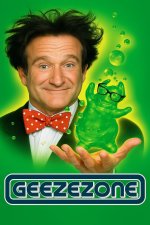
But if you grew up in that era, you already know exactly what I’m talking about.
Ever catch yourself scrolling through streaming options and thinking, “Man, movies used to feel different”?
You’re not alone.
Back in the day, Flubber wasn’t just a goofy Disney comedy; it was a wild ride where science experiments, flying cars, and Robin Williams’ boundless energy collided.
And the crazy part? We didn’t even question it.
We just sat there, popcorn in hand, totally convinced that goo could save a college and maybe even make our sneakers jump higher.
I remember watching it on VHS, rewinding the basketball scene over and over, wishing my team had a secret weapon like that. The film might not have aged into cinematic greatness, but for those of us who were kids in the ’90s, it holds a strange, sticky charm. It was silly.
It was over the top. And it was ours.
So why does this quirky movie still spark memories today?
That’s where we’re headed; back into the world of green goo, slapstick chaos, and the kind of joyful nonsense that only the ’90s could deliver.
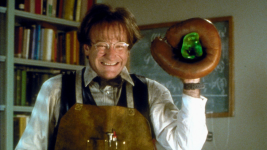
Directed by Les Mayfield and written by John Hughes with Bill Walsh, it wasn’t a fresh story but a colorful reimagining of Disney’s 1961 classic The Absent-Minded Professor. Produced by Walt Disney Pictures, the film had a hefty $80 million budget, big money for the late ’90s, and it paid off with a worldwide box office haul of about $178 million.
At its center was Robin Williams, already one of the biggest names in Hollywood. Surrounded by Marcia Gay Harden, Christopher McDonald, and a memorable voice cast, the movie carried the kind of star power that made families take notice.
The late ’90s were prime time for family-friendly comedies with wild special effects. Think Home Alone sequels, Mrs. Doubtfire, and even Jumanji, movies that weren’t afraid of being silly while pulling at heartstrings. Disney, riding high on animated hits like The Lion King, wanted to bring older live-action classics back to life. Remakes and reboots weren’t new, but Flubber fit into a larger Disney strategy of updating past successes for a new generation.
This was also the peak of Robin Williams’ career as a family entertainer. In the same year he won an Academy Award for Good Will Hunting, he was also bouncing across screens as a scatterbrained scientist covered in goo. That’s the kind of range few actors ever pull off.
Disney timed the release for Thanksgiving weekend, a high-stakes box office slot. It opened against Alien Resurrection; two very different kinds of “science” on screen. Despite mixed reviews from critics, families flocked to it. The first weekend pulled in over $36 million across five days, enough to claim the number one spot.
Home release also boosted the film’s impact. The VHS and DVD dropped in 1998, filling shelves in family living rooms across the country. For many, that’s how Flubber became a repeat watch, rewound basketball scenes, gooey slapstick on loop.
The critics might have frowned, but audiences embraced it. CinemaScore polls at the time gave it a solid “B+.” That gap between critic skepticism and audience enjoyment tells its own story: sometimes joy beats judgment.
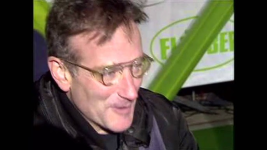
Robin Williams plays him with the same manic energy that made him beloved in the ’90s. Brainard’s defining trait is his obsession with invention, so much so that he misses his own wedding, three times.
This absent-minded genius trope gave kids someone to laugh at and adults someone to secretly sympathize with. After all, who hasn’t been so wrapped up in work or passion projects that everything else slips away?
Brainard embodies both chaos and charm. His zany experiments make a mess of his life, but they also lead to a world-changing discovery: Flubber.
The character reflects the ’90s fascination with quirky scientists, a trend seen in Honey, I Shrunk the Kids and Back to the Future.
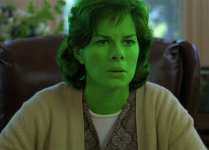
Image credit: devianart
She’s practical, ambitious, and endlessly patient, until she isn’t. Her role is more than a love interest; she represents the real-world consequences of Brainard’s eccentricity. In many ways, she’s the glue that keeps the story grounded.
Without Sara, Brainard’s inventions risk being nothing but chaos. With her, there’s purpose: save the college, save their future.
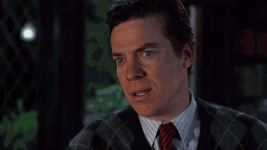
A former colleague of Brainard, he’s the classic ’90s antagonist. handsome, arrogant, and willing to steal both ideas and love interests. Croft represents betrayal and rivalry, themes that keep the story from being just slapstick.
He’s the type of character audiences love to hate, much like McDonald’s other iconic role as Shooter McGavin in Happy Gilmore.
Chester is the wealthy sponsor threatening to close Medfield College, while his spoiled son Bennett is the kind of character every ’90s teen comedy had, bratty, overconfident, and ripe for a comeuppance. Their presence adds social commentary: money versus innovation, privilege versus hard work.
They’re not the main villains, but their pressure makes Brainard’s work all the more urgent.
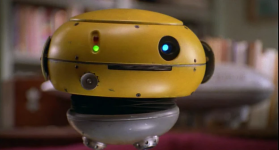
Photo credit: Fandom
With her playful personality and surprising emotional depth, she became one of the most memorable characters in the film. Her unspoken love for Brainard, culminating in her sacrifice, gave the movie an emotional weight audiences didn’t expect.
Weebo’s “daughter,” Weebette, carries on that legacy in the finale, reminding viewers that even the comic-relief sidekick can deliver the biggest heart punch.
The original The Absent-Minded Professor hit theaters in 1961 and introduced audiences to “Medfield College” and its quirky scientist. It was black-and-white, slower-paced, and very much a product of its time. Watching it today feels like stepping into another era of filmmaking, where charm carried the story more than flashy effects.
When Disney revived the tale in 1997, the studio doubled down on slapstick and CGI spectacle. The remake had more noise, more chaos, and, of course, Robin Williams’ signature energy. But here’s the kicker: many older fans of the original weren’t impressed. They felt the magic of the story got buried under goo jokes and digital trickery. Still, for kids of the ’90s (myself included), the remake became the version we remembered.
Rick Moranis played Wayne Szalinski, another absent-minded inventor who turned his family into miniatures by mistake. Both movies tapped into that childhood fantasy of science gone wild. One gave us bouncing goo, the other made an ant look like a loyal pet.
The difference?
Honey struck a balance between wonder and heart. Audiences connected with the family drama at its core. Flubber, meanwhile, leaned harder on comedy and slapstick. You could say Honey was about shrinking problems down to size, while Flubber was about blowing them up into something wacky.
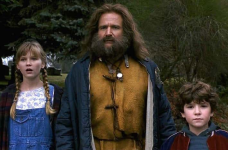
It’s not the same type of story, but the energy overlaps. Both movies threw Williams into a whirlwind of special effects and absurd scenarios. The big difference lies in tone: Jumanji had higher stakes and darker undertones, while Flubber kept things light and playful.
Still, both films showcase why Williams was the go-to guy for family adventures in the ’90s. He could make chaos feel safe, scary things feel funny, and heartfelt moments feel genuine. Ask any ’90s kid, and chances are they owned both VHS tapes.
Think Inspector Gadget (1999) with its bumbling hero and over-the-top gadgets. Or Space Jam (1996), where cartoon physics collided with real basketball. Flubber fit neatly into this wave of movies that didn’t take themselves too seriously but are still stuck in our memories.
Looking back, it almost feels like these films were made with VHS replay in mind. They weren’t just meant to be seen once in a theater. They were designed to be rewound endlessly, scenes watched over and over. In that sense, Flubber was exactly what kids wanted in the ’90s, even if critics never warmed to it.
Early drafts of the script clashed with his comedic style. Williams thrived on improvisation, but Disney wanted a tighter family comedy. There were whispers that he considered stepping back before rewrites gave him more space to let loose.
Imagine Flubber without Robin Williams; that’s a parallel universe no ’90s kid would want to visit.
Disney partnered with Ford to spotlight the classic Thunderbird. It was product placement, sure, but it also tied into the nostalgic Americana vibe Disney loved to sprinkle into family films. For Ford, it was a clever marketing move; the Thunderbird got a new wave of recognition with kids pointing at the screen and yelling, “That car can fly!” Of course, no dealership could deliver on that feature.
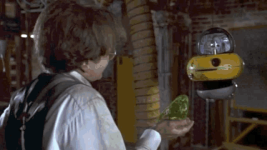
A full duplicate, complete with basement lab and observatory, was built inside an old aircraft hangar on Treasure Island in San Francisco. That’s how the production team could pull off so many chaotic experiments without wrecking an actual home.
It’s one of those behind-the-scenes details that shows just how much money Disney was willing to pour into making a family comedy look convincing.
The cameo is uncredited, but it’s a deliberate nod to the original film. These little Easter eggs weren’t as hyped in the ’90s as they are now, so plenty of people completely missed it.
For fans who catch it today, it’s a clever bridge between two generations of Disney science chaos.
Professor Brainard is brilliant, no question, but his inability to prioritize costs him dearly; especially in love. That’s a theme that resonates beyond slapstick. Who hasn’t been so focused on work or hobbies that relationships start to fray?
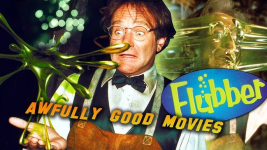
Photo Credit: JoBlo Originals
Brainard’s struggle is funny on screen, but it’s also quietly familiar.
The subplot with Chester Hoenicker makes the stakes bigger than just a missed wedding. The wealthy sponsor threatens to close Medfield College unless his spoiled son gets a better grade. This is more than cartoon villainy. It reflects the ’90s anxiety around big business swallowing smaller institutions. Brainard’s invention represents creativity and progress, while Hoenicker represents profit at any cost. It’s a battle that feels just as relevant today.
Weebo’s arc may surprise anyone who only remembers the slapstick scenes.
The little robot, secretly in love with Brainard, sacrifices herself to protect him and Flubber. For a movie filled with goo gags, this moment hits hard. It’s a reminder that even comic-relief characters can carry emotional weight. Her “daughter,” Weebette, showing up at the end gives audiences a bittersweet resolution. It’s love, loss, and second chances packaged in a Disney-friendly wrapper.
So why do kids of the ’90s still talk about Flubber today?
Because it tapped into pure wonder. The idea that sneakers could bounce higher, that cars could fly, or that goo could have a personality lit up imaginations. It wasn’t logical, and it didn’t need to be. The film permitted to believe in nonsense; joyful, chaotic nonsense.
That’s why VHS tapes got rewound until they squeaked, and why the basketball scene still lives rent-free in so many memories.
That little tug of memory isn’t random, it’s your childhood reminding you of the joy you once had in the simplest things. And Flubber was one of those joys.
We’ve revisited the slapstick chaos, the quirky genius of Robin Williams, the heartstring-pulling sacrifice of Weebo, and the way a gooey green blob somehow glued itself into pop culture. It wasn’t perfect, but it didn’t need to be. It was fun, it was weird, and it made us believe for a moment that sneakers could make us fly.
And isn’t that what nostalgia is all about? We’ve laughed at the absurdity, remembered the magic, and now we stand on the edge of those memories like they’re a trampoline, ready to bounce us higher.
Flubber was a snapshot of who we were, what made us smile, and why we still chase that spark today.
So go on, press play in your mind, let the green goo dance again, and feel that rush. The ’90s are still alive, right there in your heart.
Sounds ridiculous, right?

But if you grew up in that era, you already know exactly what I’m talking about.
Ever catch yourself scrolling through streaming options and thinking, “Man, movies used to feel different”?
You’re not alone.
Back in the day, Flubber wasn’t just a goofy Disney comedy; it was a wild ride where science experiments, flying cars, and Robin Williams’ boundless energy collided.
And the crazy part? We didn’t even question it.
We just sat there, popcorn in hand, totally convinced that goo could save a college and maybe even make our sneakers jump higher.
I remember watching it on VHS, rewinding the basketball scene over and over, wishing my team had a secret weapon like that. The film might not have aged into cinematic greatness, but for those of us who were kids in the ’90s, it holds a strange, sticky charm. It was silly.
It was over the top. And it was ours.
So why does this quirky movie still spark memories today?
That’s where we’re headed; back into the world of green goo, slapstick chaos, and the kind of joyful nonsense that only the ’90s could deliver.
Where it All Began: The Background of Flabber
Flubber landed in theaters in November 1997, right at the heart of the holiday movie season.
Directed by Les Mayfield and written by John Hughes with Bill Walsh, it wasn’t a fresh story but a colorful reimagining of Disney’s 1961 classic The Absent-Minded Professor. Produced by Walt Disney Pictures, the film had a hefty $80 million budget, big money for the late ’90s, and it paid off with a worldwide box office haul of about $178 million.
At its center was Robin Williams, already one of the biggest names in Hollywood. Surrounded by Marcia Gay Harden, Christopher McDonald, and a memorable voice cast, the movie carried the kind of star power that made families take notice.
The late ’90s were prime time for family-friendly comedies with wild special effects. Think Home Alone sequels, Mrs. Doubtfire, and even Jumanji, movies that weren’t afraid of being silly while pulling at heartstrings. Disney, riding high on animated hits like The Lion King, wanted to bring older live-action classics back to life. Remakes and reboots weren’t new, but Flubber fit into a larger Disney strategy of updating past successes for a new generation.
This was also the peak of Robin Williams’ career as a family entertainer. In the same year he won an Academy Award for Good Will Hunting, he was also bouncing across screens as a scatterbrained scientist covered in goo. That’s the kind of range few actors ever pull off.
Disney timed the release for Thanksgiving weekend, a high-stakes box office slot. It opened against Alien Resurrection; two very different kinds of “science” on screen. Despite mixed reviews from critics, families flocked to it. The first weekend pulled in over $36 million across five days, enough to claim the number one spot.
Home release also boosted the film’s impact. The VHS and DVD dropped in 1998, filling shelves in family living rooms across the country. For many, that’s how Flubber became a repeat watch, rewound basketball scenes, gooey slapstick on loop.
The critics might have frowned, but audiences embraced it. CinemaScore polls at the time gave it a solid “B+.” That gap between critic skepticism and audience enjoyment tells its own story: sometimes joy beats judgment.
Main Characters: Who Brought the Goo to Life
Professor Philip Brainard (Robin Williams)
At the center of Flubber is Professor Philip Brainard, a brilliant yet scatterbrained scientist.
Robin Williams plays him with the same manic energy that made him beloved in the ’90s. Brainard’s defining trait is his obsession with invention, so much so that he misses his own wedding, three times.
This absent-minded genius trope gave kids someone to laugh at and adults someone to secretly sympathize with. After all, who hasn’t been so wrapped up in work or passion projects that everything else slips away?
Brainard embodies both chaos and charm. His zany experiments make a mess of his life, but they also lead to a world-changing discovery: Flubber.
The character reflects the ’90s fascination with quirky scientists, a trend seen in Honey, I Shrunk the Kids and Back to the Future.
Sara Jean Reynolds (Marcia Gay Harden)
Sara is Brainard’s fiancée and the president of Medfield College.
Image credit: devianart
She’s practical, ambitious, and endlessly patient, until she isn’t. Her role is more than a love interest; she represents the real-world consequences of Brainard’s eccentricity. In many ways, she’s the glue that keeps the story grounded.
Without Sara, Brainard’s inventions risk being nothing but chaos. With her, there’s purpose: save the college, save their future.
Wilson Croft (Christopher McDonald)
Every good comedy needs a villain, and Wilson Croft fills the role with smug precision.
A former colleague of Brainard, he’s the classic ’90s antagonist. handsome, arrogant, and willing to steal both ideas and love interests. Croft represents betrayal and rivalry, themes that keep the story from being just slapstick.
He’s the type of character audiences love to hate, much like McDonald’s other iconic role as Shooter McGavin in Happy Gilmore.
Chester Hoenicker (Raymond J. Barry) & Bennett Hoenicker (Wil Wheaton)
The Hoenickers represent greed and entitlement.Chester is the wealthy sponsor threatening to close Medfield College, while his spoiled son Bennett is the kind of character every ’90s teen comedy had, bratty, overconfident, and ripe for a comeuppance. Their presence adds social commentary: money versus innovation, privilege versus hard work.
They’re not the main villains, but their pressure makes Brainard’s work all the more urgent.
Weebo & Weebette (Voiced by Jodi Benson and others)
Weebo is Brainard’s robotic assistant, voiced by Jodi Benson (yes, Ariel from The Little Mermaid).
Photo credit: Fandom
With her playful personality and surprising emotional depth, she became one of the most memorable characters in the film. Her unspoken love for Brainard, culminating in her sacrifice, gave the movie an emotional weight audiences didn’t expect.
Weebo’s “daughter,” Weebette, carries on that legacy in the finale, reminding viewers that even the comic-relief sidekick can deliver the biggest heart punch.
4 Movies That Came Close to Flubber and How They Differ
The Absent-Minded Professor (1961)
Before Flubber bounced onto the scene, Disney had already told this story.The original The Absent-Minded Professor hit theaters in 1961 and introduced audiences to “Medfield College” and its quirky scientist. It was black-and-white, slower-paced, and very much a product of its time. Watching it today feels like stepping into another era of filmmaking, where charm carried the story more than flashy effects.
When Disney revived the tale in 1997, the studio doubled down on slapstick and CGI spectacle. The remake had more noise, more chaos, and, of course, Robin Williams’ signature energy. But here’s the kicker: many older fans of the original weren’t impressed. They felt the magic of the story got buried under goo jokes and digital trickery. Still, for kids of the ’90s (myself included), the remake became the version we remembered.
Honey, I Shrunk the Kids (1989)
Now, if there was one Disney film that nailed the quirky scientist vibe before Flubber, it was Honey, I Shrunk the Kids.Rick Moranis played Wayne Szalinski, another absent-minded inventor who turned his family into miniatures by mistake. Both movies tapped into that childhood fantasy of science gone wild. One gave us bouncing goo, the other made an ant look like a loyal pet.
The difference?
Honey struck a balance between wonder and heart. Audiences connected with the family drama at its core. Flubber, meanwhile, leaned harder on comedy and slapstick. You could say Honey was about shrinking problems down to size, while Flubber was about blowing them up into something wacky.
Jumanji (1995)
Two years before Flubber, Robin Williams starred in Jumanji.
It’s not the same type of story, but the energy overlaps. Both movies threw Williams into a whirlwind of special effects and absurd scenarios. The big difference lies in tone: Jumanji had higher stakes and darker undertones, while Flubber kept things light and playful.
Still, both films showcase why Williams was the go-to guy for family adventures in the ’90s. He could make chaos feel safe, scary things feel funny, and heartfelt moments feel genuine. Ask any ’90s kid, and chances are they owned both VHS tapes.
Broader Trend: ’90s Slapstick & Sci-Fi Comedies
The late ’90s had no shortage of films that mashed up slapstick comedy with sci-fi or fantasy.Think Inspector Gadget (1999) with its bumbling hero and over-the-top gadgets. Or Space Jam (1996), where cartoon physics collided with real basketball. Flubber fit neatly into this wave of movies that didn’t take themselves too seriously but are still stuck in our memories.
Looking back, it almost feels like these films were made with VHS replay in mind. They weren’t just meant to be seen once in a theater. They were designed to be rewound endlessly, scenes watched over and over. In that sense, Flubber was exactly what kids wanted in the ’90s, even if critics never warmed to it.
5 Secrets of The Flubber That Many Don't Know
1. Robin Williams Almost Walked
It’s easy to think Robin Williams was always locked in for Flubber, but that wasn’t the case.Early drafts of the script clashed with his comedic style. Williams thrived on improvisation, but Disney wanted a tighter family comedy. There were whispers that he considered stepping back before rewrites gave him more space to let loose.
Imagine Flubber without Robin Williams; that’s a parallel universe no ’90s kid would want to visit.
2. Deleted Scenes Never Released
For a film dripping with slapstick, there were even more gags filmed than what made the final cut. One rumor suggests that Weebo had extended comedy sequences that got trimmed because test audiences felt the movie was running too long. Unfortunately, those deleted moments never surfaced on DVD extras, making them lost treasures for die-hard fans. It’s one of those cases where what we didn’t see still lingers in fan discussions.3. Ford Thunderbird Partnership
Remember the flying car? That wasn’t just a random choice.Disney partnered with Ford to spotlight the classic Thunderbird. It was product placement, sure, but it also tied into the nostalgic Americana vibe Disney loved to sprinkle into family films. For Ford, it was a clever marketing move; the Thunderbird got a new wave of recognition with kids pointing at the screen and yelling, “That car can fly!” Of course, no dealership could deliver on that feature.
4. Set Construction Trivia
The professor’s house wasn’t a single real location.
A full duplicate, complete with basement lab and observatory, was built inside an old aircraft hangar on Treasure Island in San Francisco. That’s how the production team could pull off so many chaotic experiments without wrecking an actual home.
It’s one of those behind-the-scenes details that shows just how much money Disney was willing to pour into making a family comedy look convincing.
5. Hidden Cameo Connection
Here’s one that even sharp-eyed viewers might miss: Nancy Olson, who played the professor’s love interest in the 1961 version, pops up in Flubber as a Ford Company secretary.The cameo is uncredited, but it’s a deliberate nod to the original film. These little Easter eggs weren’t as hyped in the ’90s as they are now, so plenty of people completely missed it.
For fans who catch it today, it’s a clever bridge between two generations of Disney science chaos.
Goo With a Message: Why Flubber Cut Deep To Date
Flubber was a good example of what happens when obsession blinds responsibility.Professor Brainard is brilliant, no question, but his inability to prioritize costs him dearly; especially in love. That’s a theme that resonates beyond slapstick. Who hasn’t been so focused on work or hobbies that relationships start to fray?

Photo Credit: JoBlo Originals
Brainard’s struggle is funny on screen, but it’s also quietly familiar.
The subplot with Chester Hoenicker makes the stakes bigger than just a missed wedding. The wealthy sponsor threatens to close Medfield College unless his spoiled son gets a better grade. This is more than cartoon villainy. It reflects the ’90s anxiety around big business swallowing smaller institutions. Brainard’s invention represents creativity and progress, while Hoenicker represents profit at any cost. It’s a battle that feels just as relevant today.
Weebo’s arc may surprise anyone who only remembers the slapstick scenes.
The little robot, secretly in love with Brainard, sacrifices herself to protect him and Flubber. For a movie filled with goo gags, this moment hits hard. It’s a reminder that even comic-relief characters can carry emotional weight. Her “daughter,” Weebette, showing up at the end gives audiences a bittersweet resolution. It’s love, loss, and second chances packaged in a Disney-friendly wrapper.
So why do kids of the ’90s still talk about Flubber today?
Because it tapped into pure wonder. The idea that sneakers could bounce higher, that cars could fly, or that goo could have a personality lit up imaginations. It wasn’t logical, and it didn’t need to be. The film permitted to believe in nonsense; joyful, chaotic nonsense.
That’s why VHS tapes got rewound until they squeaked, and why the basketball scene still lives rent-free in so many memories.
Bouncing Back to Where It All Began
Ever find yourself wishing you could relive a Saturday night with a stack of VHS tapes, a bowl of popcorn, and that one movie you couldn’t stop rewinding?We’ve revisited the slapstick chaos, the quirky genius of Robin Williams, the heartstring-pulling sacrifice of Weebo, and the way a gooey green blob somehow glued itself into pop culture. It wasn’t perfect, but it didn’t need to be. It was fun, it was weird, and it made us believe for a moment that sneakers could make us fly.
And isn’t that what nostalgia is all about? We’ve laughed at the absurdity, remembered the magic, and now we stand on the edge of those memories like they’re a trampoline, ready to bounce us higher.
Flubber was a snapshot of who we were, what made us smile, and why we still chase that spark today.
So go on, press play in your mind, let the green goo dance again, and feel that rush. The ’90s are still alive, right there in your heart.

